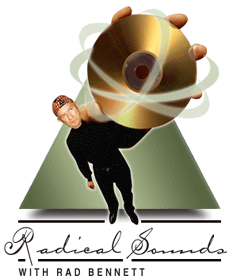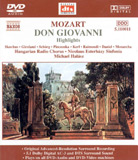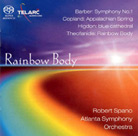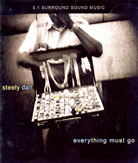 |
| September 1, 2003  Radical
Sounds: Conversations with Mark Waldrep -- Part Two
Mark Waldrep is the founder,
president, and chief engineer of AIX Records, and, along with David Swartz and Michael
Stern, co-founder and chief engineer of Hi-Res Music. Wanting answers to some questions
that arose in putting together the June "Radical
Sounds," I recently had a conversation with him. Part 1 of this conversation
appeared in last month’s column. Part 3 will appear in October. Radical
Sounds: Conversations with Mark Waldrep -- Part Two
Mark Waldrep is the founder,
president, and chief engineer of AIX Records, and, along with David Swartz and Michael
Stern, co-founder and chief engineer of Hi-Res Music. Wanting answers to some questions
that arose in putting together the June "Radical
Sounds," I recently had a conversation with him. Part 1 of this conversation
appeared in last month’s column. Part 3 will appear in October.
Rad Bennett: I have tried many DVD-Audio discs that I cannot play -- not the way I want to, anyhow -- without using a screen to display the menu. They will auto-start on the multichannel tracks, but if I want to use alternate stereo tracks -- and I often do, because the multichannel remixes are simply too "busy" -- I have to have a menu displayed to make the switch. With SACD, I only have to push a key on the remote. Do you see any way that DVD-A menus might be designed so that a screen is not required? Or might there be some other solution? Mark Waldrep: The authoring of any DVD title requires a myriad of choices by the production team. Unfortunately, not all companies or producers utilize the commands provided by the specifications in the same, or even the most intelligent, fashion. In the case of DVD-Video, many of the major studios do not take advantage of the Title/Top Menu command, even though it's the most important one of the bunch. For DVD-Audio, your expectations might be different from most. If a DVD-Audio disc is authored according to recommended practice, there is absolutely no need to have a TV monitor hooked up. The package will state which Groups contain which types of audio, and you simply use the Group selection to access the multitrack or stereo tracks. DVD-Audio uses the remote control just as SACD [does]. The practice of starting with the 5.1-channel surround tracks is, in my opinion, the correct one. I do it that way, too. If you look at the printed materials and use the Group/Track/Index controls, you have the ultimate flexibility. All that aside, I believe that the use of a screen is not necessarily a bad thing. The new Levinson No.40 has a LCD display on the front of it. The use of a screen, small or large, is the interface of the future -- have you been in a new automobile lately? That same screen can give you all of the multimedia that sets DVD-Audio apart from CD and SACD. RB: We could bat that menu topic around for hours, but let's move on to something else that has been on my mind lately. We have talked before about the need for new recordings for new formats. I know that all AIX recordings are brand-new and recorded using high-resolution multichannel equipment. Yet Hi-Res is primarily a reissue company. How do you feel about releasing older material? Should it be formatted as originally recorded? In other words, if it was originally stereo, should the DVD-A or SACD be stereo? Or do you think a recording ought to be remixed to 5.1 or some variation thereof? MW: This is a tough question for me. I have thoroughly become a multichannel surround music advocate. For Hi-Res Music, David Swartz and I agreed that stereo music should remain stereo music. The tremendous recordings that Phil Edwards has done for Concord are treasures and deserve the magic that high-resolution PCM can provide them. On the other hand, I have spoken to Phil and understand that some of the masters were recorded on eight tracks. It would be interesting to bring these tapes into the studio and create an "immersive" yet audience-based 5.1-channel surround mix for home-theater owners and multichannel advocates. It's really up to the artists and producers to dictate what they prefer. I'm convinced that just about any genre of music can be enhanced when tastefully mixed in 5.1 channels. At the recent HE2003 show, many of the press and audiophiles that came to our demonstrations suite (Meridian, Butler, Cardas, and Piega) marveled at the richness and reality of the mixes. Even some very staunch two-channel guys admitted to me that it worked for them. I’ve stated previously that making a terrific recording is a collaboration between the artists, the producer, and the engineers. Everyone has philosophies and goals for any particular project. At AIX Records, my goal as producer and engineer is to enhance the recorded music experience, and any path to that goal is fine by me. Just imagine Magical Mystery Tour or Joni Mitchell's Blue in surround. I can. RB: I have a hard time with that, Mark. I have gone on record as saying I believe that original recordings should be treated with respect and presented as the artists and producers created them. I have nothing against a new "version" of something like Blue, but believe it should take second place to the original. This is not what happens with most of Warner's releases. The new multichannel mix is presented as the end-all and be-all, and the original, which we have respected for years, is suddenly relegated to second place as an alternate. To me, putting a classic recording such as Blue into surround sound is no different from colorizing a classic black-and-white film. MW: You hit the nail right on the head: A new or reinterpreted "version" of a classic recording, similar to the remix of Peggy Lee's Fever record that I heard over the weekend (although a 5.1 mix would adhere more closely to the original). I agree with you that there is a something special about the original version of a particular album or track, but I believe it's possible to enhance a listener's experience or give them an alternative perspective on a familiar project with a carefully crafted 5.1-channel mix. I'm not talking about making Joni's dulcimer fly around the room, just offering a greater sense of space to each instrument and her vocals. Just because the technology of the time was limited to analog tape and two channels doesn't mean that creative artists, engineers, and producers would not have employed surround sound and high-resolution if it had been available. They would have made their selections based on the same motivations that resulted in the original, but they would have had a larger palette to choose from. RB: I guess we need to take these remasterings on a per-case basis. I have heard some good ones. I think Louise de la Fuente and Richard King are doing a bang-up job at putting many earlier CBS classical recordings into 5.1 sound. Perhaps some two-channel recordings just don't have the elements needed to create a multichannel master, whereas others do. Perhaps we just need producers who have the wisdom to realize the difference. MW: Artists, engineers, and producers (and journalists?) with the right sensitivities and open minds will go a long way toward making this exciting new frontier a success. Surround mixes won't work or enhance every recording, as you say, but even a simple track with just guitar and vocal can improve in a 5.1 space. RB: I have noted that multichannel configurations vary a great deal from producer to producer. Many are not the 5.1 configuration that most listeners might expect. I have encountered 4.0, 4.1, even 5.0. All of your recordings, though, seem to be 5.1. Why did you decide on that configuration? MW: Different engineers and producers are still exploring the creative possibilities of these varying setups. There's 6.1, 5.1, 2+2+2, and many more, with adherents of each. The decision to go with the standard ITU 5.1 speaker configuration at AIX Records was based partly on the installed base of home theaters, the arrangement that will dominate the DVD-Audio 5.1-channel-equipped automobiles, and our philosophy of distributing lots of stereo pairs among a perimeter of speaker channels. I record just about everything with a stereo pair of mikes, to bring more spaciousness and depth to each recorded part. Placing these pairs among the speakers provides a completely immersive experience that you just can't get through traditional recording techniques. RB: Another hot topic regarding multichannel configuration is the use of the center channel. Some producers use it for vocals. Dianne Reeves's The Calling comes to mind, where the voice is almost entirely in the center channel. Other producers use it for ambience. Still others spread the sound across all three front channels, using the center as an "anchor." What is your philosophy on the use of the center channel? MW: The center channel in a 5.1-channel surround home-theater system is primarily intended to carry the dialogue component of a soundtrack. The choice as to whether it should be used in a similar fashion for the lead vocal of a music track is, as you say, a very hot topic. As far as I'm concerned, using the center channel can benefit a proper 5.1 mix. I don't agree that a vocal or prominent solo should be panned exclusively to the center channel. Doing that "flattens" the dimensionality of the intended sound space. When I mix a vocal track like our new Cheryl Bentyne DVD project, I place her in the center and then use something called "Focus" on my Euphonix System 5 console to bleed the image from the single speaker to the left and right. The phantom center still exists, and there is still some signal directed to the center speaker, but the majority of the level is coming from the stereo pair. This results in a fuller sound. It also means that our mixes will sound great in a home-theater system that might have a center speaker of lesser quality. Finally, I've heard of mixers who avoided the center channel altogether, which resulted in customers feeling cheated because there was no sound coming from the center-channel. We’ll continue and wrap up this discussion in October. In the meantime, here are three great recordings I heard this go-round that made the search for the best entirely worthwhile.
Opera offers some of the most exciting possibilities for advanced-resolution formats -- possibilities that are also sure to engender a lot of controversy. This DVD-Audio disc contains 76 minutes of one of the greatest operas in the repertory. It is very well played and sung, though none of the singers other than its Don Giovanni, Bo Skovhus, is that well known. The small chamber orchestra plays exceptionally well, and the production is conducted with tremendous flair and undeniable energy. In fact, this is such a good performance that I wish the whole opera had been released. It is also singularly well recorded. The dynamic range is good and the sound is rock-solid across the entire frequency range, from singularly focused double-bass sonorities to detailed upper-violin timbres. It is the perspective that raises the specter of controversy. Most tracks are laid out with modest reverberation, orchestra and singers spread across the front soundstage, which has excellent width and depth. In the finale, however, as Don Giovanni is dragged off to his hell, the sound opens up, with the chorus of demons in the back speakers. This seems appropriate, but the ballroom scene, which places specific singers in the surrounds, might not please all listeners. I rather like the idea, as it involves the listener more in the action, but there are sure to be those for and against. Almost all will be against the omission of any texts. This is a DVD-Audio release and so could have contained some video content; texts could have been made available as an onscreen option, but they are neither there nor in the printed booklet.
This is a tremendously exciting, energized recording. The two familiar pieces, the Barber and Copland works, receive no-holds-barred performances in broad, sweeping statements that seem entirely appropriate to the scores. The Atlanta Symphony proves again that it is one of this country’s very best orchestras. The winds are of virtuoso caliber, the strings sound rich and full, the brass section regal and majestic, the percussion alert and always on the mark. Though most will buy this disc for the first-rate performances of the tried-and-true masterpieces, it is Theofanidis’s Rainbow Body that makes it a must for me. Based on "Hail Mary, Source of Life," a chant by the medieval mystic Hildegard von Bingen, the work is a short tone poem of tremendous beauty and power. This is spiritual music of the highest order, with a climax of such beauty and power that I found it impossible to sully my listening experience with anything else for 15 minutes afterward. Telarc’s 5.1-channel SACD recording is rich and spacious, somewhat forward, and very immediate, yet never strident or harsh. The stereo layer sounds a bit pallid and undernourished by comparison. Based on this disc's achievement, I hope that the Atlanta Symphony will soon record more music by American composers. I’d love to hear this combination of artists and engineers bag Hanson’s "Romantic" Symphony.
This is another breezy, funky, jazz-tinged outing from Walter Brecker, Donald Fagen, and some amazing sidemen. The mood is always hip, whether satirizing contemporary life or lamenting its demise. "I like the neon. I like the music anachronistic but nice," from "Green Book," sums it up. Whatever you think of Steely Dan’s logic, this DVD-A must be heard for its sound. Every instrument is clearly delineated while remaining part of an overall soundfield. The result is a clarity usually only dreamed of. The surrounds are used extensively, yet never detract from the action up front. Clearly, this set was designed with 5.1 in mind. Another plus: This DVD-A came out almost day and date with the CD. The release date gap is getting closer. For added pleasure, there is a funky bonus -- a video of a cab drive around Las Vegas with passengers Fagen and Brecker, who make wry comments about their work in general and the new album in particular. ...Rad Bennett
Ultra Audio is part of the SoundStage! Network. |
 Mozart: Don Giovanni: Highlights
Mozart: Don Giovanni: Highlights Barber: Symphony No. 1
Barber: Symphony No. 1 Steely Dan: Everything Must Go
Steely Dan: Everything Must Go